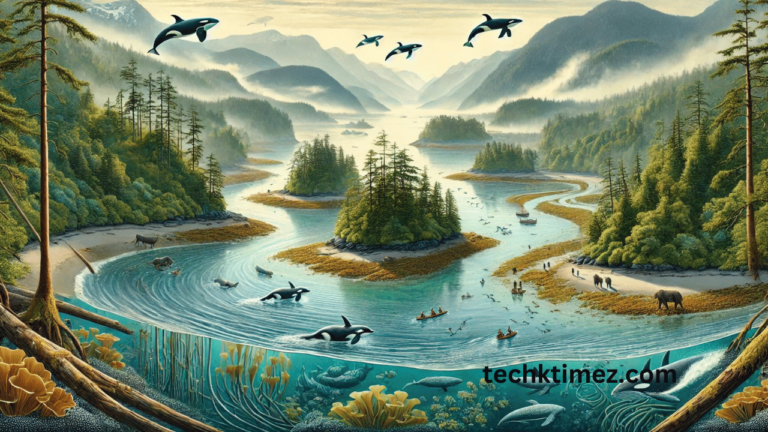The labyrinthine straits and sounds of the Northwest Coast present a magnificent tapestry of natural beauty and ecological complexity that is as challenging as it is crucial for both local ecosystems and human activities. This region, known for its rugged coastlines and rich marine habitats, serves as both a critical pathway for maritime navigation and a vital refuge for countless marine species. This article delves into the significance, challenges, and conservation efforts associated with these vital waterways.
The Strategic and Ecological Significance of the Northwest Coast Waterways
The labyrinthine straits and sounds of the Northwest Coast are not only pivotal for their breathtaking landscapes but also for their strategic importance in maritime navigation. The Strait of Juan de Fuca, serving as a gateway between the Pacific Ocean and the inner waterways of Washington State, illustrates this dual role perfectly. It supports international shipping lanes that are essential for commerce and provides a playground for recreational boating enthusiasts, offering unparalleled views of the surrounding mountains and islands.
Similarly, the Dixon Entrance marks a critical boundary between the United States and Canada, near the Alaska Panhandle. It’s a vital segment of the Inside Passage, a sheltered maritime route that supports significant commercial and recreational traffic from Washington State to Alaska. The entrance’s waters are also rich in marine resources, crucial for the local fishing industry, yet they are vulnerable to environmental threats such as pollution and climate change.
Navigational Challenges and Biodiversity in Hecate Strait
The Hecate Strait, located between the Haida Gwaii archipelago and the British Columbia mainland, exemplifies the navigational challenges posed by the Northwest Coast’s waterways. Known for its turbulent waters and treacherous winds, the strait demands respect and careful navigation from all who traverse its waters. Despite these difficulties, or perhaps because of them, the Hecate Strait is a biodiversity hotspot, teeming with marine life from whales and dolphins to vast kelp forests, which provide critical habitat and feeding grounds for various marine species.
Conservation Efforts and Educational Initiatives
Recognizing the ecological value and vulnerability of these regions, numerous conservation initiatives and educational programs have been implemented to protect and sustain the labyrinthine straits and sounds of the Northwest Coast. The Northwest Straits Foundation, for instance, offers workshops aimed at helping shoreline landowners adopt practices that enhance their property’s stability and ecological function without compromising the health of the marine ecosystem. These programs emphasize the importance of using native vegetation and soft-armoring techniques to manage erosion and support wildlife habitats.
Furthermore, the SoundIQ program provides a digital platform that facilitates access to comprehensive data about the straits and sounds, promoting informed decision-making and ongoing research that support conservation efforts. This initiative helps both the public and specialists understand the intricate relationships within these marine environments and the impacts of human activities on their health and sustainability.
The Role of Local Communities and Stakeholders
The involvement of local communities and stakeholders is crucial in the stewardship of the Northwest Coast’s waterways. From individual landowners and local fishermen to governmental agencies and non-profit organizations, a collaborative approach is essential to address the multifaceted challenges facing these regions. By participating in restoration projects, educational workshops, and conservation programs, local communities play a direct role in sustaining the health and vitality of the labyrinthine straits and sounds of the Northwest Coast.
Promoting Sustainable Tourism and Recreation
The labyrinthine straits and sounds of the Northwest Coast are not only vital for their ecological and economic significance but also serve as popular destinations for tourism and recreation. Ensuring that these activities are conducted sustainably is crucial to maintaining the health of the ecosystems. Educational programs aimed at tourists and recreational boaters can help raise awareness about the importance of preserving these natural settings.
Future Directions for Research and Policy
Continued research is essential for understanding the complex dynamics of the labyrinthine straits and sounds of the Northwest Coast. Studies focusing on the impacts of environmental change on marine habitats, as well as the effectiveness of conservation strategies, are particularly valuable. Policymakers can use this research to craft regulations that effectively balance human use with ecological preservation.
Conclusion
The labyrinthine straits and sounds of the Northwest Coast embody a complex interplay between natural beauty and ecological challenges. Preserving these areas requires a concerted effort from all sectors of society, including ongoing research, community engagement, and policy reform. By appreciating and actively participating in the conservation of these vital waterways, we can ensure that they continue to sustain a rich diversity of life and remain vibrant parts of our natural heritage.
FAQs About the Labyrinthine Straits and Sounds of the Northwest Coast
- What are the main threats to the labyrinthine straits and sounds of the Northwest Coast?
- The primary threats include climate change, pollution, overfishing, and the impacts of coastal development.
- Why is the Strait of Juan de Fuca important for international shipping?
- It serves as a major shipping lane connecting the Pacific Ocean with the ports of Seattle and other cities along the inside waterways, facilitating international trade and commerce.
- How do conservation efforts help protect the Hecate Strait?
- Conservation efforts such as the establishment of marine protected areas, restrictions on fishing, and habitat restoration projects help preserve the biodiversity and ecological health of the Hecate Strait.
- What role does the local community play in conserving the Northwest Coast’s marine environments?
- Local communities engage in conservation efforts through participation in educational programs, supporting local conservation initiatives, and adopting sustainable practices that minimize environmental impacts.
- Can the navigational challenges of the Northwest Coast’s waterways be mitigated?
- While some navigational challenges are inherent due to natural conditions, improvements in navigation technology, comprehensive maritime training, and effective management of maritime traffic can reduce risks and enhance safety for mariners.


